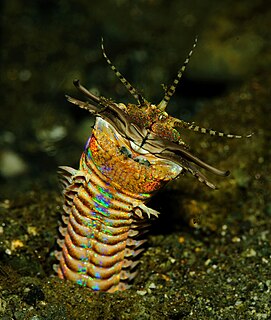
Haplodrili, or Archiannelida, is an order of primitive polychaete worms. Zoologist Ray Lankester gave it the name haplodrili, while zoologist Berthold Hatschek later named it Archiannelida. Once considered to be a class under Annelida, and even a separate phylum, Haplodrili is now widely accepted to be an order under Polychaeta. Species in this order are known for completely lacking external segments.

Pectinariidae, or the trumpet worms or ice cream cone worms, are a family of marine polychaete worms that build tubes using grains of sand roughly resembling ice cream cones or trumpets. These structures can be up to 5 centimetres (2 in) long. The earliest pectinariid fossils are known from the Cretaceous.

Spionidae is a family of marine worms within the Polychaeta. Spionids are selective deposit feeders that use their two grooved palps to locate prey. However, some spionids are capable of interface feeding, i.e. switching between deposit and suspension feeding.

Lanice,, is a genus of burrowing marine polychaetes typically found in the littoral zone.

Hesionidae are a family of phyllodocid "bristle worms". They are marine organisms. Most are found on the continental shelf; Hesiocaeca methanicola is found on methane ice, where it feeds on bacterial biofilms.
Vermetus eruca is a species of sea snail, a marine gastropod mollusk in the family Vermetidae, the worm snails or worm shells.

Alitta succinea is a species of marine annelid in the family Nereididae. It has been recorded throughout the North West Atlantic, as well as in the Gulf of Maine and South Africa.

Eunicida is an order of polychaete worms.

Sabellastarte spectabilis is a species of benthic marine polychaete worm in the Sabellidae family. It is commonly known as the feather duster worm, feather duster or fan worm. It is native to tropical waters of the Indo-Pacific but has spread to other parts of the world. It is popular in aquariums because of its distinctive appearance and its ability to remove organic particles and improve water quality.

Palpata is a subclass of polychaete worm. Members of this subclass are mostly deposit feeders on marine detritus or filter feeders. Palpata has become superfluous with the elevation of Canalipalpata to subclass.

The Onuphidae are a family of polychaete worms.

Eulalia viridis is a species of bright-green polychaete worm in the family Phyllodocidae. It can range from 5 to 15 cm in length and is usually found in shallow north Atlantic water under rocks or in mussel beds.
Pettais a genus in the polychaetefamily Pectinariidae.

Scalibregma inflatum, also known as T headed worm, is a burrowing marine polychaete. It is a cosmopolitan species that can be found from the Arctic to Antarctica, although most probably several species are confounded.
Syllis castroviejoi is a species of polychaete from the family Syllidae. The body of this worm consists of a head, a cylindrical, segmented body and a tail piece. The consists of a prostomium and a peristomium and has paired appendages.

Phyllodocidae is a family of polychaete worms. Worms in this family live on the seabed and may burrow under the sediment.
Eulalia clavigera is a species of polychaete worm in the family Phyllodocidae, native to the coasts around Britain, through Western France, and to the Iberian Peninsular. It closely resembles Eulalia viridis, and there has been confusion in the past as to the identification of the two species.

Scolelepis squamata is a species of polychaete worm in the family Spionidae. It occurs on the lower shore of coasts on either side of the Atlantic Ocean.

Syllidae is a family of small to medium-sized polychaete worms. Syllids are distinguished from other polychaetes by the presence of a muscular region of the anterior digestive tract known as the proventricle.
















